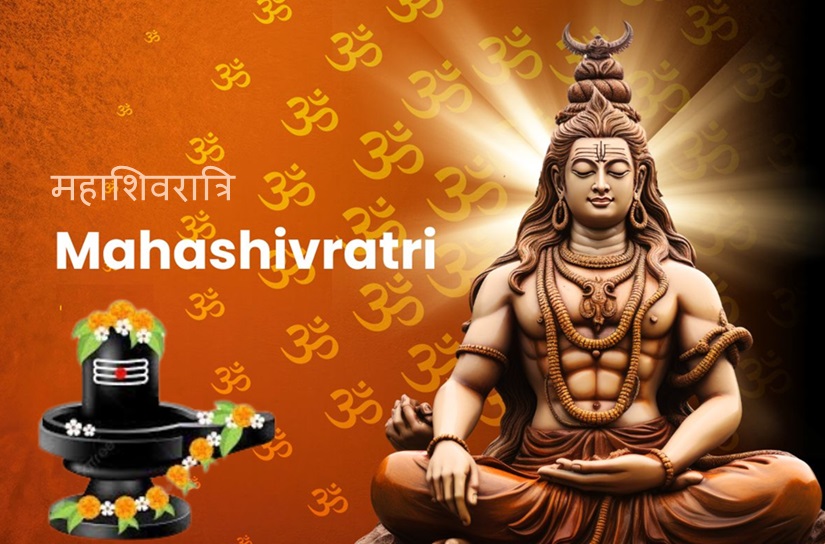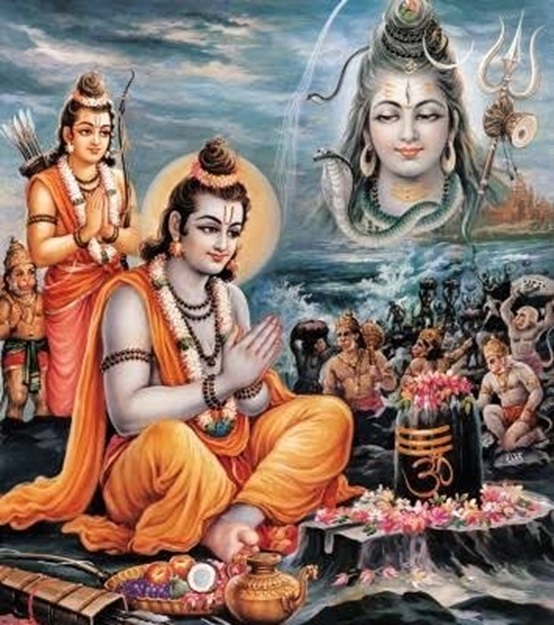
Maha Shivaratri
महाशिवरात्रि पूजा
Maha Shivratri - Facts , Significance , Prayers , Puja And Festivals
Maha Shivaratri is a festival dedicated in honour of Lord Shiva to seek his blessings and Krupa. Devotees perform special puja. महाशिवरात्रि पूजा.
Mahashivratri 2024 Date
महाशिवरात्रि 2024 तिथि
Maha shivaratri festival is going to be celebrated on Chaturdashi Tithi of Krishna Paksha in the month of Phalguna i.e., on March 8, 2024. Chaturdashi Tithi will start from March 8, 09:57 PM and it will end on March 9, 06:17 PM in the evening.
Experience The Exuberance Of Lord Shiva's Devine Energy - The Great Night Of Lord Shiva
Maha Shivaratri is a festival dedicated in honor of Lord Shiva to seek his blessings and krupa. It is one of the most revered festivals in Hinduism and is celebrated with great fervor and devotion by millions of devotees worldwide.
Observed annually on the 14th day of the dark fortnight in the Hindu lunar month of Phalguna (February–March). Maha Shivaratri holds profound spiritual significance and serves as a time for devotees to perform a special puja, Upasana, and experience the exuberance of divine energy.

Lord Shiva, the cosmic dancer, is a divine entity of unparalleled magnificence. He embodies the paradoxical roles of both destroyer and creator, symbolizing the cyclical nature of existence.
In Hindu mythology, Lord Shiva is revered as the supreme deity who balances the cosmic forces of creation, preservation, and destruction. His dance, known as the Tandava Nritya , represents the rhythm of life, wherein every movement holds profound significance.
Story Of Maha Shivaratri
Maha Shivaratri, literally translates as ‘the great night of Shiva’ . As per Hindu Scriptures and Purana’s , it is on this night that Lord Shiva performs his heavenly cosmic dance or ‘Tandava Nutrya’ representing creation, preservation and destruction. The Shivratri festival also celebrate the day when Lord Shiva married to Goddess Parvati, thus the union of Prakriti and Purusha for the well-being of the world.
In this comprehensive exploration, we delve into the significance, celebrations, puja rituals, and other relevant topics associated with Maha Shivaratri.
Ancient Powerful Lord Shiva Mantras
Join us on a spiritual journey as we explore the divine essence of Lord Shiva’s energy on this auspicious day of Maha Shivaratri. Known as the destroyer and creator, Lord Shiva is a revered deity in Hindu mythology. In this article, we will delve into His teachings, captivating mythology, and time-honored worship rituals especially on the auspicious day of Shivratri.
Maha Shivaratri Significance
Maha Shivaratri, meaning the “The Great Night of Shiva,” holds immense significance in Hinduism for several reasons:
- Union of Shiva and Shakti: Maha Shivaratri symbolizes the divine union of Lord Shiva, the masculine principle of consciousness, and Goddess Parvati, the feminine principle of energy and creativity. It represents the cosmic dance of creation, preservation, and destruction.
- Remembrance of Lord Shiva’s Marriage: According to Hindu mythology, Maha Shivaratri commemorates the divine marriage of Lord Shiva and Goddess Parvati. Devotees believe that observing the festival with devotion can bring blessings for marital harmony and happiness.
- The Night of Spiritual Awakening: Maha Shivaratri is considered an auspicious time for spiritual practices such as meditation, prayer, and introspection. It is believed that devotees who observe vigil on this night with sincerity and devotion can attain spiritual awakening and liberation from the cycle of birth and death.
Celebrations of Maha Shivaratri
Maha Shivaratri is celebrated with great enthusiasm and zeal across India and in Hindu communities worldwide. The celebrations typically include the following rituals and traditions:

- Night-long Vigil (Jagran): Devotees observe vigil throughout the night, singing devotional songs, chanting mantras, and offering prayers to Lord Shiva. The atmosphere is filled with spiritual fervor as devotees immerse themselves in worship and meditation.
- Abhishekam (Ritual Bathing of Shiva Lingam): One of the central rituals of Maha Shivaratri is the ceremonial bathing of the Shiva Lingam (symbol of Lord Shiva) with milk, water, honey, yogurt, and other auspicious substances. This ritual symbolizes purification, renewal, and devotion.
- Offerings and Puja: Devotees offer Bilva leaves, flowers, fruits, and other sacred items to Lord Shiva as a gesture of reverence and devotion. Special puja rituals are performed in temples and homes, accompanied by the chanting of Vedic hymns and mantras.
- Fasting (Upvaas): Many devotees observe a strict fast on Maha Shivaratri, abstaining from food and water for the entire day or consuming only fruits and milk. Fasting is believed to purify the body and mind and facilitate spiritual elevation.
- Visiting Temples: Thousands of devotees throng to Shiva temples across the country to seek the blessings of Lord Shiva on Maha Shivaratri. Temples are adorned with elaborate decorations, and priests conduct special ceremonies throughout the day and night.
महा शिवरात्रि की पूजा विधि
Puja Rituals of Maha Shivaratri
The puja rituals associated with Maha Shivaratri vary from region to region, but some common practices include:

- Preparatory Rituals: Devotees begin the day with a ritual bath (snan) and wear clean clothes as a sign of purity and devotion.
- Dhyana (Meditation): Devotees meditate upon Lord Shiva, focusing their minds on his divine form and attributes. Meditation is believed to foster inner peace, clarity, and spiritual awareness.
- Pranayama and Yoga: Many devotees practice pranayama (breath control) and yoga asanas (postures) as part of their Maha Shivaratri observance. These practices help purify the body, calm the mind, and enhance spiritual well-being.
- Abhishekam: The ritual bathing of the Shiva Lingam is performed with reverence and devotion. Devotees pour milk, water, honey, yogurt, and other sacred substances over the Lingam while chanting mantras.
- Offerings and Arati: Devotees offer Bilva leaves, flowers, fruits, and sweets to Lord Shiva as a mark of devotion. Arati (waving of lamps) is performed, accompanied by the singing of hymns and bhajans in praise of Lord Shiva.
- Prayer and Mantra Chanting: Devotees recite Vedic hymns, prayers, and mantras dedicated to Lord Shiva throughout the day and night. The chanting of the Maha Mrityunjaya Mantra is especially popular, believed to confer protection and longevity.
महा शिवरात्रि कि पौराणिक कहानियाँ
Maha Shivaratri Legends And Mythological Stories
Maha Shivaratri is associated with several legends and mythological stories that highlight the divine significance of the festival:
समुद्र मंथन
The Churning of the Ocean
According to Hindu mythology, Maha Shivaratri commemorates the day when Lord Shiva drank the poison ( halahala – Sanskrit हलाहल ) that emerged from the churning of the ocean by gods and demons. His act of swallowing the poison saved the universe from destruction and earned him the title of Neelkantha (the blue-throated one). Because of this poison, Shiva’s throat turned blue.
Gods And Deamons Performing Samudra Manthana

During Samudra Manthan (churning of the ocean), gods and demons cooperated to obtain Amrita, the elixir of immortality. Lord Vishnu incarnated as Kurma, the tortoise, to support Mount Mandara used as the churning rod.
As the ocean churned, it yielded various treasures and poison. Lord Shiva consumed the poison to save the universe, earning the title Neelkantha (blue-throated).
Lord Shiva Consumes Poison

Finally, Dhanvantari emerged with the pot of Amrita, leading to a fierce battle. Lord Vishnu intervened and distributed the Amrita among the gods. However, a demon disguised as a god tried to obtain it, but Lord Vishnu severed his head with his Sudarshana Chakra.
The Marriage of Lord Shiva And Goddess Parvati
Another popular legend associated with Maha Shivaratri is the divine marriage of Lord Shiva and Goddess Parvati. Devotees believe that observing the festival with devotion can bestow blessings for marital harmony and happiness.

Lord Shiva and Goddess Parvati’s divine union, celebrated as their marriage, depicts the harmonious merging of masculine and feminine energies. Parvati, after years of penance, won Shiva’s heart with her devotion.
Their celestial wedding, witnessed by gods and sages, symbolizes love, companionship, and the cosmic balance between creation and destruction, fostering spiritual and worldly prosperity.
तांडव नृत्य
The Night of Shiva's Tandava Dance
It is believed that Lord Shiva performs the cosmic dance of Tandava – तांडव नृत्य (the dance of destruction) on the night of Maha Shivaratri. Devotees stay awake throughout the night, singing and dancing in celebration of Shiva’s divine grace and cosmic power.

Lord Shiva performs the Tandava, a vigorous dance of creation and destruction, to maintain cosmic order and rhythm. The Tandava (तांडव नृत्य) represents the eternal cycle of birth, life, and death, embodying the dual nature of existence.
It signifies the balance between creation and dissolution, expressing Shiva’s role as the destroyer of illusion and the harbinger of transformation.
The dance’s powerful movements symbolize the cosmic forces of destruction and renewal, reminding devotees of the impermanence of worldly existence and the eternal nature of the soul’s journey towards liberation.
Conclusion
The Great Night Of Lord Shiva
In conclusion, Maha Shivaratri is a sacred festival that holds profound spiritual significance and serves as a time for devotees to honour and seek the blessings of Lord Shiva, the supreme deity of destruction and transformation.
This is one of the best days for devotees to experience the transformational power of Lord Shiva’s divine energy. Through rituals, prayers, fasting, and meditation, devotees express their devotion and surrender to the divine will of Lord Shiva, seeking spiritual upliftment, purification, and achieving Moksha that is liberation from the cycle of birth and death.

Maha Shivaratri is not just a festival but a transformative spiritual journey that enables devotees to connect with the divine essence of Lord Shiva and experience the eternal bliss of oneness with the universe.
As devotees immerse themselves in the celebration of Maha Shivaratri, they awaken to the profound truth that the essence of Lord Shiva resides within their own hearts, guiding them on the path of righteousness, wisdom, and divine love.
Jai Bhole Nath!



